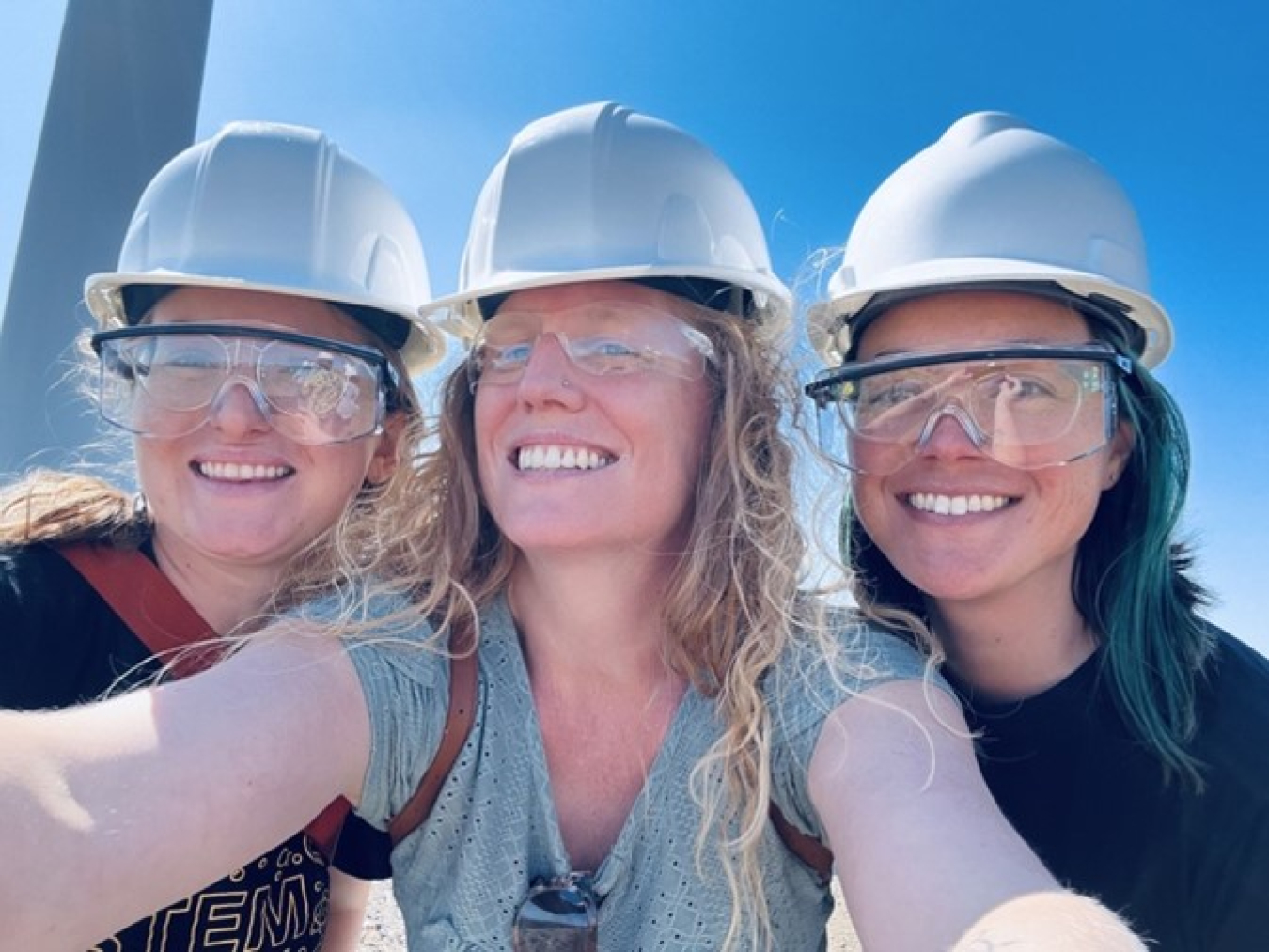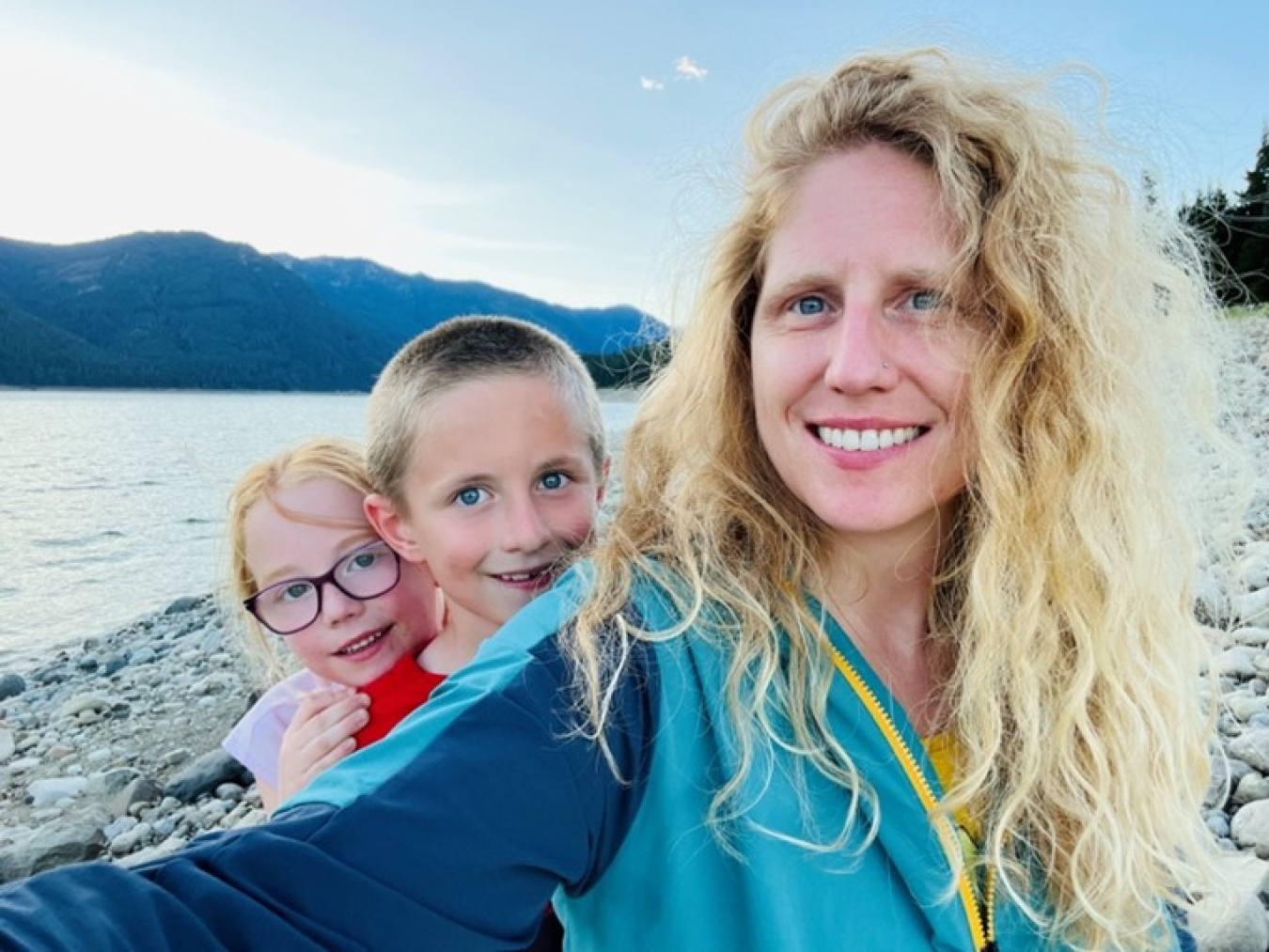The wind energy workforce is made up of a wide range of people and skills. Learn about the career journey of PNNL lab program manager Alicia Mahon.
Wind Energy Technologies Office
September 17, 2024
Mahon (center) on a field trip with PNNL Researchers Noelani Boise (left) and Erin Walters in summer 2024.

Mahon presented research on the buoys at a PNNL workshop in May 2024.
As a kid growing up in New Jersey, Alicia Mahon’s favorite place was the beach. It instilled in her an early love for the environment—along with a strong urge to protect it.
“I was a Girl Scout my whole life,” said Mahon. “I camped and I did all things outdoors, so that, too, fed that love of the environment.” Mahon also excelled at math and science, so high school teachers encouraged her to explore a career in engineering.
During undergraduate studies at Stevens Institute of Technology in Hoboken, New Jersey, Mahon took up environmental engineering, but quickly learned the field wasn’t what she expected. “Turns out that’s not focused on coastal protection, which is what I wanted to do,” said Mahon. She ultimately found coastal and ocean engineering, where she did a lot of work related to the coastal and nearshore environment, including analyzing shoreline impacts from coastal storms. “I realized that was what I liked. I finally found the thing!”
Mahon is now putting her passion for the beach—and her Ph.D. in coastal and ocean engineering—to good use as the Operational Systems Engineering Group Leader and Wind Energy Program Manager at the Pacific Northwest National Laboratory (PNNL). Here, Mahon talks about the evolution of her career, from long days doing fieldwork on the beach as a grad student to leading major initiatives from the U.S. Department of Energy’s (DOE’s) Wind Energy Technologies Office (WETO).
First, how and when did you come to PNNL?
After grad school I knew I wanted to do research, but I did not want to go into academia. I felt like a national laboratory was a good fit. So, in 2014, soon after school and after a short stint working for DOE, I started at PNNL in the marine energy portfolio and spent several years looking at the environmental effects of wave energy and tidal energy. Because there is some overlap when it comes to the environmental impacts of marine energy and offshore wind, I eventually transferred over to the offshore wind portfolio.
Are there accomplishments you’re particularly proud of from that research period?
I led an ongoing project in partnership with the National Renewable Energy Laboratory called the U.S. Offshore Wind Synthesis of Environmental Effects Research, or SEER, project. Part of that effort was to develop a series of research briefs on some of the hot environmental topics that stakeholders are really interested in—like the environmental effects of offshore wind. We also put together a whole webinar series where we engaged external subject matter experts, which is still publicly available.
The other major accomplishment I’m proud of is the Lidar Buoy Program, particularly, the deployment of the buoys off the coast of California in 2020 and 2021—just because of the challenges and roadblocks of having to do it all during COVID-19. We knew that there was going to be a west coast offshore lease sale in late 2022, so we wanted to collect data about the wind characteristics in those areas and make it available to developers as soon as possible to help inform their leasing strategy. When I took the program over, the buoys were just sitting in storage, so watching the buoys be deployed was great!
Tell me more about your current job at the lab.
I now have two major roles: The first one is as the lab relationship manager between PNNL and DOE. That means I manage our DOE-funded wind energy research portfolio, including all of our land-based, distributed, and offshore wind projects. I work with researchers and project managers to iron out their scope, schedule, and budget and interact with DOE wind energy program managers to make sure our research is meeting the mark.
I also coordinate the lab’s response to funding opportunities from WETO, or entities like the National Offshore Wind Research and Development Consortium or Bureau of Ocean Energy Management. To that end, I also ensure that PNNL’s capabilities and focus are aligned with WETO’s.
For example, a few years ago WETO and the industry in general started to put an emphasis on stakeholder engagement and exploring community perceptions of offshore wind energy. In response, we created a new capability space in our portfolio around community values and ocean co-use—addressing knowledge gaps in the sustainable development of offshore wind and enabling planners and developers to engage communities more effectively in collaborative decision-making. This will help lay the foundation for meaningful collaboration and partnerships with federal, state, local, and Tribal governments, regional and local planning groups, developers, and other stakeholders engaging communities in offshore wind projects.
My other role, which I started in January 2024, is acting as a group leader for our Operational Systems Engineering Group. I supervise about 80 staff focused on addressing challenges ranging from hydropower and ecological systems to border security and nuclear systems. Many staff in this group work on enhancing operational performance and reliability of hydropower systems, and we do a lot of work in the environmental performance space. This role is much more people-focused!
What do you love about your work?
I have this really nice balance between program management, portfolio management, and people management. I don't know if there are a lot of other places where you have the opportunity to make your own adventure and create opportunities for yourself to leverage your skill set and do things that you know you're passionate about and that you're good at. And for me, this combination is absolutely perfect.

Mahon camping with family.
And what do you do for fun outside of work?
I still take every opportunity I can to be outside, whether it's hiking, camping, paddleboarding, fishing—all the things. Just being outside!
I also love music and grew up dancing and doing musical theater (if I didn't go to school to be an engineer, I would have gone to school for musical theater). I sing in local choirs, so it’s still a big part of my life! And I’ve got two kids, so I spend a lot of time with family.
Finally, do you have any advice for people interested in a career in wind energy?
Don't just jump into research. Get boots-on-the-ground, hands-on experience, whether it's an internship with a developer or someone in industry or working at a wind farm—that can really help you understand the ins and outs of how the industry and turbine technology works.
I'm lucky that I just kind of fell into it, because I didn’t go to school for it, but I’ve had to learn as I go. People that have that background and experience, in my opinion, just have a leg up over everybody else. And for a hiring manager, that experience is very valuable!

